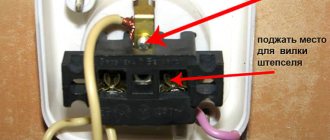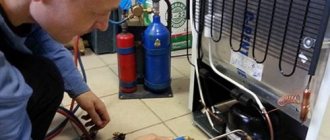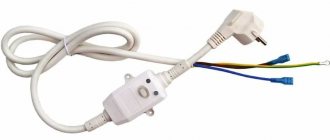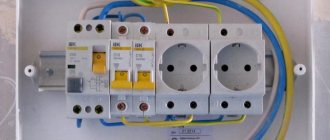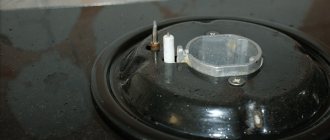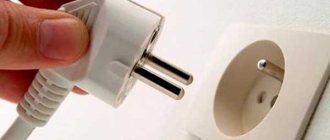What kind of outlet is needed for a water heater?
The boiler must be grounded, so to connect it you will need a three-pole socket. If the water heater is installed in the bathroom, then the outlet must be moisture resistant.
Interesting materials:
How should a woman wash herself properly? How should you fast correctly? How to pay a traffic fine if you lost your receipt in Ukraine? How to stop tears If you want to cry? How to format a flash drive if it is write protected? How to disable AdBlock in Chrome if it doesn't exist? How to unscrew a bolt if it turns? How to unscrew a screw if you don't have a Phillips screwdriver? How to open a file in VK if the user is blocked? How to unsubscribe from those who do not follow you?
Video description
Why does the socket get hot?
Socket
The power of the element often does not correspond to the characteristics of the equipment that is connected to electricity. On average, a boiler socket must withstand 16 A. At maximum load, the component heats up and sparks. The problem arises when installing low-quality Chinese products or using old Soviet models.
If the installation rules are not followed and the insulation of the conductors is broken, a breakdown occurs. Incorrect use or sudden pulling of the plug from the socket often leads to loosening of the structure. The contacts weaken or oxidize, which provokes a change in temperature.
Parts of an electrical device Source materialexpert.ru
The electrical device may become warm when connecting the washing machine in the bathroom. In rooms with high humidity, it is necessary to use elements with moisture protection. Users in the bathroom install a regular outlet or power the equipment through an extension cord from another room. Under unfavorable conditions, contacts oxidize, which leads to breakdown.
An advanced malfunction is easy to notice visually during inspection. Defects appear on the plastic when the panel melts. The device can be checked by connecting to it a device with a known working plug. If the plug or housing is warm, the problem is with the electrical element.
Device failure Source poradu24.com
To find out why the outlet is heating up, the device must be disassembled. Before starting work, be sure to turn off the power to the apartment. Unscrew the bolt from the structure and remove the cover. For a built-in model, the fastening tabs are loosened; for an overhead model, the screws are removed. To move the element away from the wall, you need to bend the electrical cable slightly.
When diagnosing, carefully inspect the springs and contact plates. Carefully examine the plastic and metal parts of the outlet. The malfunction manifests itself in the form of charred or melted elements. When exposed to high temperatures, polymer components crack.
Wiring
Electrical networks indoors are designed for a certain load. When laying the system, engineers calculate the maximum throughput parameters. In older buildings, wiring is oriented towards lower energy consumption than is accepted by modern standards. The more electrical appliances running, the greater the pressure.
In new buildings or in private homes, people often neglect the rules. Unscrupulous construction companies carry out calculations with violations. When laying the wiring yourself, the wiring is not done according to the technology or deviates from the requirements.
Extension cord with devices included Source 220.guru
When creating electrical networks in residential buildings, aluminum cables with a diameter of 2.5 mm are used. This design will withstand a current of up to 20 A or a voltage of 4.4 W. If several powerful devices (boiler, oil heater) are simultaneously connected to one pair, then the operating norm will be exceeded. When used regularly at maximum settings, the plug in the socket heats up.
To find out the limiting parameters of a pair, measurements are needed. The load is determined using the formula. The cross-section of the wire should be cleaned using a compass. The cable diameter is squared and multiplied by 0.785. The resulting result is compared with the readings in a special table.
Household voltage readings Source lightika.com
If the parameters of the contact pair are greater than the data for electrical appliances in the instructions, then the wiring copes with the voltage. If it is exceeded, the plug of the device in the socket will heat up. The calculations must take into account all equipment that is connected to the system.
Danger of current
Electric current, to which we are so accustomed that we don’t even think about it, is actually a very dangerous invention of mankind. Being invisible and intangible, electric current poses a mortal threat to humans and a potential danger to the home.
The danger of electric current occurs not only in serious emergency situations, such as a short circuit or exposure of live wiring elements. There is a hidden danger of current, which manifests itself in heating, overheating and further fire of electrical wiring sections, in particular at the places of connections and connections.
Why are there short circuits in wires and contacts?
The main factor of a short circuit is a breakdown of the insulation of current conductors. Violation of the integrity of the insulating sheath of wires, breakdown of contact resistance in an electrical or electronic circuit - all this causes a short circuit.
The main causes of short circuits include:
- high voltage surge;
- insulation wear;
- mechanical damage;
- penetration of foreign objects;
- lightning strike.
High voltage surge
Voltage fluctuations in the centralized power grid are often observed in remote areas of rural areas; such cases also occur in urban environments.
During a voltage surge that far exceeds the permissible standard, the risk of breakdown of the insulation of wires or electrical circuits increases sharply. A situation is created in which the wiring shorts and a short-term arcing may occur.
Insulation wear
The old dielectric sheath of wires dries out over time and can self-destruct. Failure to replace old wires over decades often leads to short circuits.
Mechanical damage
External mechanical impact on the electrical network leads to damage to the insulating layer of conductors. An example of this would be drilling into walls with hidden wiring. A drill caught between the wires causes a short circuit.
Penetration of foreign objects
Dust and small debris that get inside the housing through the cracks of the ventilation grille of an electrical or electronic device most often provoke the occurrence of a short circuit between the elements of the device. Short circuits are sometimes caused by insects and small rodents.
Lightning strike
Natural electrical discharge “attracts” the electromagnetic field of various electrical equipment. A powerful magnetic circuit can become the target of lightning.
Load determination using wire cross-section
Table for selecting cable cross-section depending on the load
To control the wiring capabilities and determine the maximum load for a specific electrical network, you need to find out the cross-sectional area of the wire and perform calculations:
- First, you should determine the diameter of the core using a caliper. The actual cross-sectional area is found using the formula: Sф.=0.785*D2. Instead of “D”, substitute the measurement result.
- To calculate the specific current and power, you must find the difference between the maximum and minimum values in the interval in which the calculated cross-sectional area falls. The difference in specific current strength is divided by the difference in cross sections in the same interval, where the smaller value is index 1, and the larger value is index 2, namely Isp. = (I2-I1)/(S2/S1). The value is obtained in A/mm2. Specific power is found in a similar way: Nsp.=(N2-N1)/(S2/S1). The required current and power values are calculated using the formulas: Isq.=(Sph.-S1)*Isp.+I1 and Nsq.=(Sph.-S1)*Nsp.+N1.
If the values obtained in the calculations are less than those indicated in the instructions for electrical appliances, the cause of heating is weak electrical wiring.
Useful tips
When performing repair work on an electrical circuit, it is important to follow a few tips. Let's highlight the main ones: Let's highlight the main ones:
Let's highlight the main ones:
- Always check the voltage level before carrying out repairs.
- If possible, call a specialist for electrical repairs.
- Install high quality machines. This requirement also applies to wires, sockets and switches.
- For safety, use cotton tape (it provides better insulation).
- The appearance of visual damage or thinning of the metal indicates the need to replace the socket.
Please note that electricity is deadly and should not be trifled with. If any problems arise with the outlet, junction box or input panel, it is better to fix the problem immediately.
Delaying repairs often leads to aggravation of the situation, damage to household appliances and even a fire.
Additionally, working on an electrical circuit without the proper knowledge may result in exposure to voltage, serious internal injury, or death.
How to prevent critical heating of the zero?
Since on the scale of an apartment the influence of higher harmonics is insignificant, we will immediately move on to the problem of poor electrical contacts. If you find a problem area in the apartment panel where the electrical connection is heating up, then first of all turn off the input circuit breaker and make sure that after that the current does not flow. The best way to test is to use a combination of a voltage probe and a multimeter set to AC current.
Once you are sure the power is off, loosen the offending terminal (usually a screw terminal) to remove the wire. Clean it, as well as the clamp. If the panel wiring is made with stranded copper wire, then its ends must be tinned or crimped. After this, you can collect the contact. It should be taken into account that “pinching” the wire with a screw connection is as undesirable as a weak clamp.
Direct contact of copper and aluminum is unacceptable, since these materials form a galvanic couple, as a result of which the electrical resistance of such a connection will increase quite quickly.
If the installation was carried out using thin wires, then it is advisable to replace them. How to choose the right cross section depending on the load current is described on our website.
Phase imbalance protection
The best option for this case is to install a voltage relay.
Voltage relay
This device will provide protection against both voltage drops and excessive increases. As an alternative solution, we can suggest installing a stabilizer for the entire apartment. Despite the higher cost, the advantages are obvious - “sag” or overvoltage will not cause a power outage.
Video description
Why does the outlet get hot and how to fix it.
Malfunctions in the plug
Models with a cast body cannot be disassembled. If a problem is detected during operation, the sealed structure should not be attempted to be repaired. The wire is carefully cut with a construction knife, the ends of the cable are stripped and fixed to a new plug.
If the model is collapsible, then you can eliminate the faults. If the screw is loose, tighten the part using a screwdriver until it stops. When the insulating material burns, the melted area is cut off, the cable is stripped and fixed on the nut. Oxidation on the contacts is removed with sandpaper.
Collapsible design Source uk-parkovaya.ru
Having determined why the outlet is heating up, it is easy to eliminate the problem yourself. The plug must fit the installed electrical outlet. For technical reasons, the Soviet model should not be connected to a modern design, so it is better to replace the outdated version with a new one.
Wiring irregularities
If the electrical network was installed more than 20 years ago, then the system must be changed. Energy demands have increased significantly. The minimum load in Soviet times barely reached 10 A, so the owners had enough of 2 sockets in each room. Outdated wiring will not withstand the simultaneous inclusion of high-power and medium-sized equipment.
The electrical network in the home is changed when the cable cross-section is small. The wire may be modern copper, but its characteristics are not suitable for the loads. In old houses they used models with a diameter of 1.5 mm. During active use, the network heats up, which causes the machine to turn off.
To keep the sockets from getting hot Source air-ventilation.ru
If you know why the plug in the socket heats up when the washing machine and kettle are running at the same time, then it’s worth replacing the system. When updating the electrical network, they are guided by the actual power. A coefficient for the future reserve is added to the obtained parameters.
Fire
If you don’t figure out why the plug in the socket is heating up, a fire may occur. Failure inside the structure or improper use of an electrical device leads to a fire. Ignition occurs when there is a short circuit in the wiring.
You can extinguish a burning or smoking socket only after turning off the power. Quickly unscrew the plugs or deactivate the machine lever on the electrical panel. To avoid electric shock, do not touch the cable or cord with bare hands. If there is no access to the switch, then use pliers to pull out the problematic element. The tool is only suitable with rubberized handles.
The socket on the wall is on fire Source lider-press.by
It is forbidden to extinguish sockets with water, so the procedure is carried out using powder, carbon dioxide or chemical fire extinguishers. In the absence of special equipment, knock down the flame with a dense natural cloth, which is applied to the flaming element. You can cover the fire with dry sand or earth.


